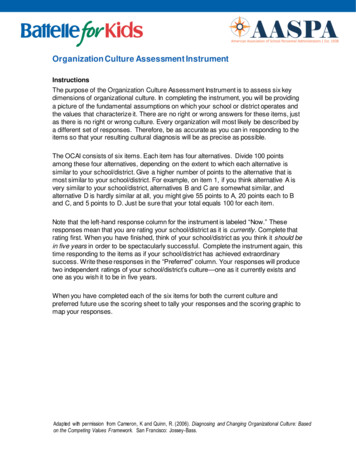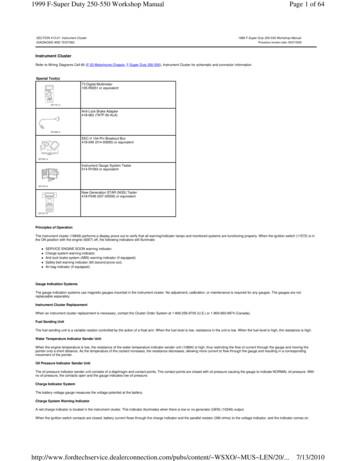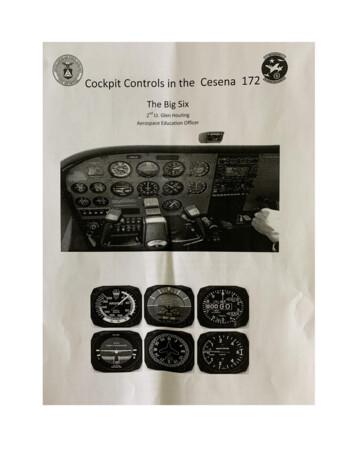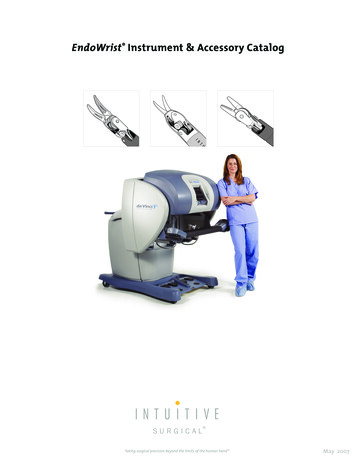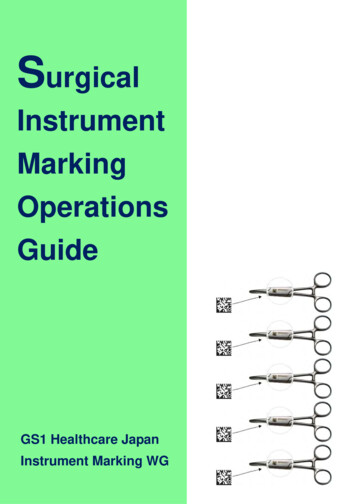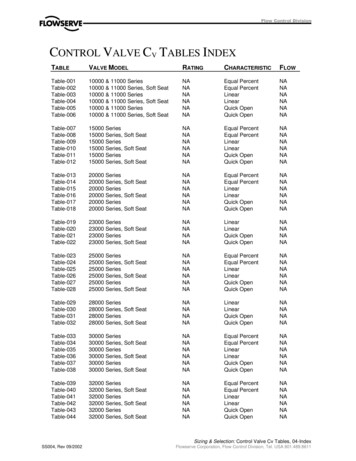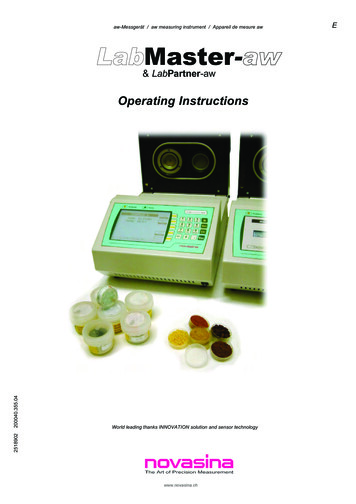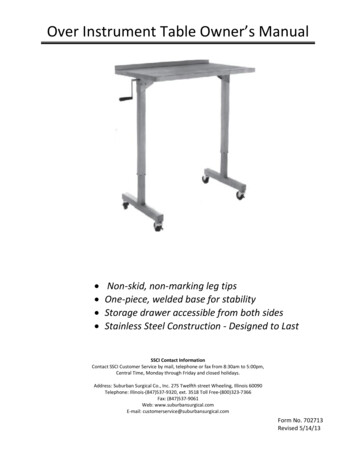
Transcription
Over Instrument Table Owner’s Manual Non-skid, non-marking leg tipsOne-piece, welded base for stabilityStorage drawer accessible from both sidesStainless Steel Construction - Designed to LastSSCI Contact InformationContact SSCI Customer Service by mail, telephone or fax from 8:30am to 5:00pm,Central Time, Monday through Friday and closed holidays.Address: Suburban Surgical Co., Inc. 275 Twelfth street Wheeling, Illinois 60090Telephone: Illinois-(847)537-9320, ext. 3518 Toll Free-(800)323-7366Fax: (847)537-9061Web: www.suburbansurgical.comE-mail: customerservice@suburbansurgical.comForm No. 702713Revised 5/14/13
Page 2Care and Cleaning of Stainless Steel IntroductionStainless steel is steel alloyed with chromium to make it highly resistant to stain, rust, andcorrosion. Note: This does NOT mean that stainless steel will never rust or corrode. Science has not yetdeveloped a steel which is completely stainless or corrosion PROOF. The type of stainless steel and finishselected by SSCI for this product is the best available for the intended use.Cleaning and CleansersThe basic rule of thumb is to use the mildest cleaning procedure that will do the job effectively.Always rinse thoroughly with clear water, and dry completely. Frequent cleaning will prolong the servicelife of stainless steel equipment and will help maintain a bright, pleasing appearance. Ordinary depositsof waste and fluids can usually be removed with soap and water. More stubborn deposits or tightlyadhering debris may require harder scrubbing. They also may possibly require the use of commercialcleaning products acceptable for use on metal surfaces. When using any cleaning agent, rub in thedirection of the polish lines or “grain” of the metal. For high luster finishes, clean soft cloths or padsshould be used. If especially rough cleaning is necessary, use “stainless steel” wool, nylon or plasticscrubbers. Test these scrubbers in an inconspicuous area first to be sure they do not mark or scratch thestainless steel finish. Minor scale build-up and some hard water spotting may be removed by washingwith some vinegar, followed by a neutralizing rinse with clear water. A thorough drying with a soft clothshould follow. For heavy deposits of scale, 5% oxalic acid (use warm), 5-15% sulfuric acid, or 5-10%phosphoric acid may be used. Always follow with a neutralizing rinse of clean water and a thoroughdrying. The carts are fully cart-washable.Deodorizing Agents, Disinfectants & SanitizersThe large selection of brands and combinations of chemicals available for deodorizing,disinfecting and sanitizing is staggering. Select one or more agents for use in your facility only afterweighing in all the benefits claimed by each product. Often this choice is made without adequateconsideration of the effects these agents may produce on equipment or furnishings.Avoid prolonged use of chlorides (such as chlorine bleach), bromides, iodides and thiocyanateon stainless steel surfaces as these chemicals will cause pitting, corrosion and metal discoloration.Allowing salty solutions to evaporate and dry on stainless steel may also contribute to corrosiveconditions. In summary, select chemical deodorizers, disinfectants and/or sanitizers only after weighingin all possible outcomes and known adverse effects.CAUTION: Before selecting a chemical to employ in your facility, review label statements regarding usewith metals (stainless steel). Always consult the chemical supplier if there are any doubts.CAUTION: The warranty for this product is void if the care and cleaning instructions provided in thismanual are not followed.www.SuburbanSurgical.com
Page 3Chapter 1 – General InformationIntroduction .4About this Manual . 4Information and Safety Notices . .4Note: . .4CAUTION: . . .4Replacement Part Numbers.5Parts Ordering Procedure . . . 6Unpacking and Inspection 6Returning the Cart for Repairs .6RMA Numbers .6Packing and Shipment 6Warranty . 7Chapter 2 – AssemblyGeneral .8Parts Included .8Tools Required . .8Procedure . 9Chapter 3 – Use & CareRaising and Lowering the Table . .12Moving the Raise/Lower Handle to the Other Side . 12Storing the Raise/Lower Handle . .12Moving the Table . 12Using the Wheel Brakes . .13Using the Instrument Table with Other Equipment . .13Chapter 4 – CleaningIntroduction . 14Cleaning Procedures . .14Chapter 5 – Care and Maintenance of Wheel/Caster AssemblySafety Tips 15Inspection . . .15Frames and Fasteners .15Wheels . .15Casters . . . .15Brakes .16Lubrication . . . . .16Recommended Lubrications . .16Lubricating the Lifting Gears .17Chapter 6 – Parts Replacement ProceduresTable Top Assembly .18Leg Assemblies 19Connecting Rod .19Casters . .20Chapter 7 – TroubleshootingThe Table is hard to Raise or Lower .21The Table does not Roll Freely 22The Table Rolls even when the Brakes are on .22www.SuburbanSurgical.com
Page 4Chapter 1- General InformationIntroductionSSCI’s Classic Tubular Base Exam Table features a one-piece, welded, Type 304 Stainless Steel tubularbase for strength, durability, and easy cleaning. A stainless steel drawer, accessible from either side, ismounted under the table top to keep supplies close at hand. Non-skid, non-marking rubber tips on allfour legs enhances stability, protect your floors, and reduce noise.About this ManualEvery attempt has been made to insure that the information in this manual is correct andcomplete. SSCI, however, always welcomes our customer’s suggestions for improvements to ourproducts and associated publications.Information & Safety NoticesThroughout this manual you will find text under the headings Note: & CAUTION: The textfollowed after “Note:” will assist you with additional information about the subject being discussed. Thetext followed after “CAUTION:” is there to alert you to potentially hazardous conditions which, if ignoredor mishandled, could result in injury to yourself or damage to the equipment.For Example:Note: This does NOT mean that stainless steel will never rust or corrode. Science hasnot yet developed a steel which is completely stainless or corrosion PROOF.CAUTION: To reduce the possibility of injury, we recommend that unpacking,assembling, installations and replacement operations involving these componentsbe done by at least two people.www.SuburbanSurgical.com
Page 5Figure 1-1Table Top AssemblyRaise/Lower HandleLeft LegAssemblyRight Leg AssemblyConnectingRod(Under TableTopAssembly)Plain Casters(2 - at rear)Casters w/Brake(2 – at front)Note: The Over Instrument Table’s Product Number is P/N 108431-23.Part NameSSCI Part NumberQuantityReplacementInstructionsTable Top Assembly2031181Page 18Right Leg Assembly2088541Page 19Left Leg Assembly2088531Page 19Connecting Rod7504621Page 19Caster, Plain8511282Page 20Caster, w/ Brake8511992Page 20Raise/Lower Handle2031191-Replacement Parts for the Instrument Tablewww.SuburbanSurgical.com
Page 6Parts Ordering ProcedureOrder new equipment, accessories and replacement parts directly through SSCI Customer Service.You can order by mail, telephone, or fax. Refer to SSCI Contact Information in front for address,Telephone, and fax numbers. When ordering, please provide the following information: Your name Company name Company account number Telephone number Fax number e-mail address Shipping address Billing address (if different from shipping address) Names, part numbers, and quantities of items being ordered Credit card number and expiration date, or other payment information Preferred method of shipment Information on whether the items are required on a normal or urgent basisUnpacking andInspectionCAUTION: Unpacking the Instrument Table is not difficult. However, it is heavy and we recommendthat unpacking be done by at least two people.If the shipping container appears damaged in any way, contact the shipping company immediately. Saveall damaged packing materials to assist in proving liability for damage.Carefully inspect your exam table top while you unpack it. If any damage is noted, or if parts appear tobe missing, call SSCI Customer Service at (800) 323-7366.Returning the Table for RepairsRMA Numbers:If your instrument table should require return to SSCI for repairs, discuss the problem with oneof our Customer Service Representatives. Obtain an RMA number (Return MerchandiseAuthorization) from them before shipping the item back.Note: Merchandise returned without an RMA number will not be accepted.Packing and Shipment:If you were able to keep the exam table shipping carton, repack the cart into the carton, andstaple or tape the cover securely in place. If the original shipping carton is not available, pack itas best you can to protect it during shipment. Ship documentation with the table including: Destination RMA Number Your name, company, and address Your telephone number A description of the reason for returning the cartwww.SuburbanSurgical.com
Page 7WarrantySuburban Surgical Company, Inc. warrants the original purchaser that all equipment manufactured bySuburban Surgical Company, Inc. will be of the highest standards in material and workmanship. Allequipment manufactured by Suburban Surgical Company, Inc. will be warrantied for a period of (1) yearfrom the date of shipment from the factory.Components and casters Suburban Surgical Company, Inc. purchases from other manufacturers will becovered by the respective manufacturer’s Warranty.Warranties will not apply if it is determined by Suburban Surgical Company, Inc. that the equipmentbecame defective due to an accident, misuse, abuse, or alteration. Warranties do not include freightcharges for replacement or repair.www.SuburbanSurgical.com
Page 8Chapter 2 – AssemblyGeneralThis section guides you in assembling the SSCI Over Instrument Table. If you have problems or requireadditional assistance, please feel free to call SSCI Customer Service at (800) 323-7366.CAUTION: Unpacking and assembling the instrument table is not difficult. The table is not heavy,however, handling it can be awkward for one person. We recommend that unpacking and assemblybe done by at least two people.Parts Included: (See Figure 2-1)(A) Table top assembly - P/N 203118(B) Raise/lower handle - P/N 203119(C) Right leg assembly - P/N 208854(D) Left leg assembly - P/N 208853(E) Connecting rod - P/N 750462(F) Caster, plain (2) - P/N 851128(G) Caster, w/brake (2) - P/N 851199(H) Plastic bag, containing: Cap screw, .312”-18 x .75” (8) - P/N 850206 Flat washer, .312” ID (8) - P/N 850706 Lock-washer, split, .312” ID (8) - P/N 850716ADCGFFigure 2-1EHBTools Required:1. 1/2 in. wrench2. 1-3/4 in. wrenchwww.SuburbanSurgical.com
Page 9Procedure:1. Place the table top assembly, up-side-down, on the floor. (Figure 2-2).Note: Use a carpet or other soft surface to protect the stainless steel top.2. IMPORTANT: Put the raise/lower handle on each leg (Figure2-8), and lower the leg to its lowestposition. Both legs must be in the same position to prevent a misalignment during assembly.3. Refer to Figure 2-3 and select the RIGHT leg assembly.Figure 2-2Back-railMounting FlangeRightLeftLeg Mounting HolesUnderside of Table Top Assembly Showing LegMounting flangesFigure 2-3Right and Left Leg Assemblies4. Fasten the RIGHT leg assembly to the top assembly with four cap screws, flat washers, and lockwashers (Figure 2-4). (The lock-washer goes between the flat washer and the head of the capscrew.)Note: The handle hook on the leg should be toward the front of the table.5. Push the connecting rod onto the gear shaft on the RIGHT leg assembly (installed) with the“flat” on the rod aligned with the flat on the gear shaft (Figure 2-5). Push the rod all the wayonto the shaft.www.SuburbanSurgical.com
P a g e 10Right LegAssemblyHandleHookCap Screw,Lock-washer,Flat-washer (4)Figure 2-4Back-railMounting the RIGHT LegRight LegAssemblyConnectingRod FitsOver GearShaftFigure 2-5ConnectingRodAttaching the Connecting Rod6. Connect the other end of the connecting rod to the gear shaft on the LEFT (not installed) legassembly, and then fasten this leg to the bottom of the table with cap screws, flat washers, andlock-washers (Figure 2-6).Note: The handle hook on the LEFT leg will be toward the rear of the table.Left LegAssemblyHandle HookConnectingRodBack-railFigure 2-6Mounting the LEFT Legwww.SuburbanSurgical.com
P a g e 11Plain CasterCaster w/ BrakeFigure 2-7Rear of TableFront of TableMounting the Casters7. Thread two casters into each leg assembly (Figure 2-7) and tighten with a 1-3/4 in. wrench.Note: The casters with the brakes go into the front positions. (The front of the table is the sideaway from the top tray back-rail.)8. Turn the table right-side-up.9. Insert the raise/lower handle in place on the gear shaft on either side of the table (Figure 2-8).Align the flat on the handle with the flat on the gear shaft.Raise/Lower HandleGear ShaftFigure 2-8Mounting theRaise/Lower HandleAssembly is complete. Your SSCI Over InstrumentTable is now ready for use.Note: The shipping carton can be cut up and thrown away. If adequate space is available, however, itmight be handy to retain the carton in case reshipment of the table to the manufacturer for repairs everbecomes necessary.www.SuburbanSurgical.com
P a g e 12Chapter 3 – Use and CareRaising and Lowering the TableRaise or lower your instrument table by simply turning the raise/lower handle (Figure 3-1). Thetelescoping legs move the table from a low position of 39 in. to a high position of 62 in. (99.06 cm to157.48 cm).Figure 3-1Raise/Lower HandleHole in LegMountingBracketFigure 3-2Handle HookStoring the Raise/Lower HandleMoving the Raise/Lower Handle to the Other SideFor your convenience, the raise/lower handle can be used on either side of the table. To move it, justpull it off the gear shaft on the leg to which it is attached, and put it onto the gear shaft on the oppositeleg.Storing the Raise/Lower HandleThe raise/lower handle can be stored away when not in use. Place the handle shaft into the hole in theleg mounting bracket and rest the handle in the handle hook (Figure 3-2). Storage positions are providedon both sides of the table.Moving The TableTo move the table, release the wheel brakes, move the table to its new location, and then engage thebrakes again.www.SuburbanSurgical.com
P a g e 13CAUTION: The wheel brakes should be engaged any time the table is not actually being moved. Beespecially careful when the table is not on a level surface and may be free to roll uncontrolled.ONOFFFigure 3-3Brake shown OFF (OFF pedal down)Wheel Brake ON/OFF PedalUsing the Wheel BrakesBrakes are mounted on the front two casters on the table. To engage a wheel brake, step down on theend of the brake lever marked ON (Figure 3-3). To release the brake, step down on the side marked OFF.CAUTION: The wheel brakes should be engaged any time the table is not actually being moved. Beespecially careful when the table is not on a level surface and may be free to roll uncontrolled.Using the Instrument Table with Other EquipmentThe mobility and versatility of the instrument table allows you to use it with other equipment for fast,easy access to instruments, supplies, and/or monitoring equipment. Figure 3-4 shows how theinstrument table can be used with an operating table.Figure 3-3Over Instrument Table Used With aHeated, V-Top, Operating Table on a Pedestal Basewww.SuburbanSurgical.com
P a g e 14Chapter 4 – CleaningIntroductionYou will no doubt want to clean your exam table whenever it becomes dirty or saturated with wastefluids. Maintaining high standards of sanitation will be an important priority for your facility. Refer toCare and Cleaning of Stainless Steel on the back of the cover page for more detailed information.Cleaning ProceduresRinse the table with clear water and dry thoroughly with clean, soft cloths.Ordinary deposits of waste and fluids can usually be removed with soap and water. Stubborn depositsmay require scrubbing with “stainless steel” wool, nylon or plastic scrubbers and/or the use ofcommercial cleaning products. Always scrub in the direction of the “grain” of the metal. Rinse with clearwater and dry thoroughly with clean, soft cloths.Minor scale build-up and some hard water spotting may be removed by washing with vinegar, followedby a neutralizing rinse of clear water and a thorough drying with clean, soft cloths.For heavy deposits of scale, 5% oxalic acid (use warm), 5-15% sulfamic acid, or 5-10% phosphoric acidmay be used. As always, rinse with clear water and dry thoroughly with clean soft cloths.Avoid prolonged use of chlorides (such as chlorine bleach), bromides, iodides, and thiocyanates. Neverallow salty solutions to dry on the stainless steel.CAUTION: The warranty for this product is void if the care and cleaning instructions provided in thismanual are not followed.www.SuburbanSurgical.com
P a g e 15Chapter 5 - Care and Maintenance of Wheel/Caster AssemblySafety Tips:Always remember, the most important safety step for casters is regular and proper maintenance. Usersare responsible for the proper operation and maintenance of their equipment. Any piece of equipmentwill become inefficient and unsafe if abused or subjected to improper demands for which it was notdesigned. If equipment is regularly maintained and not abused, you will get the maximum safety andservice performance from your casters. Always observe the following rules: Never overload the cart. Never drop heavy loads on the cart. Never subject the cart to operation at high speeds.These actions create severe impact and shock loads that can lead to wheel, caster, and equipmentfailure.InspectionFrames and Fasteners:Periodically turn the equipment on its end or side and check the following: Look for broken welds or deck boards. Tighten all loose bolts and nuts. Look for frame distortion caused by overloads and impact loads. Distorted frames can lead towheel failure by placing disproportionate loads on one or two casters. Always use locknuts or lock washers when mounting casters. Be sure that casters with expanding applicators in tubular-framed equipment are firmly in place.Wheels:Check wheels for visible tread wear. Flat spots may indicate an accumulation of foreign material,such as string, thread, or hair, which can cause the wheel to bind. Remove the axle bolt and nut,if possible, and clean out foreign material, and check internal components for ware or failure.Reassemble if the parts are not damaged. The guards may be installed if foreign material is apersistent problem.Loose casters and frozen wheels can also cause flat spots. Proper maintenance, especiallytightening of bolts, proper lubrication, and replacement of damaged casters will enhanceequipment roll ability and tracking performance.Badly worn or “chunked out” rubber tires can also cause erratic steering, bumping, load shifting,and damage to floors. We recommend that replacement casters, wheels, or bearings be kept onhand to reduce costly downtime.After the wheels have been inspected and repaired, be sure the axle nut is properly tightened.Use lock washers or locknuts on all axels. If the caster axel is loose, tighten immediately. Thewheel may lock up or become damaged if it is not straight in the caster horn.Casters:Check the swivel assembly for excessive play due to ware. If the swivel assembly is loose,replace the fork or the entire caster. If the caster has a king bolt and nut, make sure it isfastened securely. If the swivel does not turn freely, check for corrosion or dirt binding theraceways. Again, it may be necessary to replace the swivel assembly or the entire caster.www.SuburbanSurgical.com
P a g e 16Brakes:Check brakes for proper operation. Apply brakes one at a time and attempt to move theequipment to make sure that each brake is not slipping or loose. If brakes slip due to worn ordamaged wheels, replace the wheels immediately and retest the brakes. If the brake mechanismitself is not operating properly, repair or replace it. Before returning the equipment to use,always retest the brakes.Lubrication:Some caster assemblies have grease fittings and some do not. On casters with grease fittings,lubrication is essential. The lubrication schedule will depend on your specific application andworking conditions. Normal conditions warrant lubrication every six months, however, for wetor corrosive applications, monthly lubrication may be necessary.Regular lubrication adds to the life of wheel and swivel bearings. A little lube spillover to frictionpoints on the wheel hub, thrust washer, and leg surface of straight roller bearing systemsreduces drag and improves roll ability.Wheel/Caster assemblies with grease fittings usually have two: one for the wheel and one forthe swivel. Use enough grease to fill the bearing, but not so much that it oozes out of the greaseseal. After applying the grease, turn the wheel or swivel several times in both directions todistribute the grease evenly.WheelGreaseFittingSwivelGreaseFittingFigure 5-1Recommended Lubrications:SSCI recommends that you use either of the following greases when lubricating your cart casters:o Citgo EP-1o Exxon Beacon EP-1Based on available information, these products are not expected to produce adverse effects onhealth when used for the intended application and the recommendations provided in the MaterialSafety Data Sheets (MSDS) are followed. MSDS’s are available via the internet.Power Towed Operation:Power drawn equipment such as in a tow line or mechanically moved by conveyor will requirecasters, wheels, and bearings specifically designed for this use. Please consult the factory forcaster recommendations for each specific towing or power drawn equipment application.www.SuburbanSurgical.com
P a g e 17Lubricating the Lifting GearsWhen the table is built at the factory, the lifting gears in the leg assemblies are liberally coated withgrease to promote smooth, quiet operation. After the table has been in service for a long time, it ispossible for these gears to go dry. If, after a number of years of use, the table becomes hard to raise andlower, or if the motion becomes noisy, inspect the gears as follows:1. Remove the raise/lower handle.2. Turn the table up-side-down on a carpet or other soft surface to prevent damage to thetable top.3. With a 1/2 in. wrench, remove the eight cap screws, washers and lock-washers that hold thetwo leg assemblies and the connecting rod to the table top (Figure 6-1).4. Examine the lifting gears in each leg assembly (Figure 2-3). They should be well coated withgrease. If the gears are dry, obtain some white lithium grease (available at your localhardware store under the name “Lubriplate”), and apply a generous coating to the gears.5. Attach the handle to the gear shaft on each leg and rotate it several times in both directionsto distribute the grease evenly.Note: When you are finished, be sure to leave each leg in the lowest position to facilitatereassembly.6. Reassemble the table.www.SuburbanSurgical.com
P a g e 18Chapter 6 – Parts Replacement ProceduresThe following sections guide you in replacing worn, damaged, or missing parts on theinstrument table.Table Top Assembly (P/N 203118)Tool Required:1. ½-in. wrenchProcedures:1. Remove the Raise/Lower handle.2. Turn the table up-side-down.3. With a ½-in. wrench, remove the eight cap screws, washers, and lock-washers that hold the two legassemblies and the connecting rod to table top (Figure 6-1)LegAssemblyConnectingRodCap Screw,Lock-washer,Flat-washer(2 each side)Figure 6-1Removing the Leg Assemblies and theConnecting Rod4. Lay the new table top up-side-down on a carpet or other soft surface to prevent damage. Make surethat the back-rail is on the same side as the old one.5. IMPORTANT: Put the raise/lower handle on each leg, and lower the leg to its lowest position. Bothlegs must be in the same position to prevent a misalignment during assembly.6. Place both leg assemblies and the connecting rod onto the underside of the top and fasten themdown with the hardware removed above. Note: Place each leg assembly onto the same side of thetop that it was on before.7. Turn the table right-side-up.8. Replace the raise/lower handle.www.SuburbanSurgical.com
P a g e 19Leg Assemblies (Right (P/N 208854), Left (P/N 208853))(Refer to Figure 2-3 for identification)Note: The right and left leg assemblies are similar and the replacement procedures are the same forboth.Tools Required: ½-in. wrench 1-3/4-in. wrenchProcedure:1. Remove the raise/lower handle.2. Lay the table up-side-down on a carpet or other soft surface to prevent damage.3. With a 1-3/4 in. wrench, remove both the casters from the leg that is being replaced.4. With a 1/2 in. wrench, remove the four cap screws, washers and lock-washers that hold the legassembly to table top (Figure 6-1).5. Disconnect the bad leg assembly from the connecting rod and remove the leg.6. IMPORTANT: Put the raise/lower handle on each leg (Figure 2-8), and lower the leg to its lowestposition. Both legs must be in the same position to prevent a misalignment during assembly.7. Connect the vacant end of the connecting rod to the gear shaft on the new leg assembly, andthen fasten this leg to the bottom of the table with the hardware removed above.8. Install the casters to the new leg assembly. Remember that the caster with the brake goes onthe front.9. Turn the table right-side-up.10. Replace the raise/lower handle.Connecting Rod (P/N 750462)Tool Required: ½-in. wrenchProcedure:1. Remove the raise/lower handle.2. Lay the table up-side-down on a carpet or other soft surface to prevent damage.3. With a 1/2 in. wrench, remove the four cap screws, washers and lock-washers that hold one ofthe leg assemblies (either one) to table top (Figure 6-1).4. Disconnect the connecting rod from both leg assemblies and remove the rod.5. IMPORTANT: Put the raise/lower handle on each leg (Figure 2-8), and lower the leg to its lowestposition. Both legs must be in the same position to prevent a misalignment during assembly.6. Connect the one end of the new connecting rod to the gear shaft on the leg that is still on thetable.7. Connect the vacant end of the connecting rod to the gear shaft on the loose leg assembly, andthen fasten this leg to the bottom of the table with the hardware removed above.8. Turn the table right-side-up.9. Replace the raise/lower handle.www.SuburbanSurgical.com
P a g e 20Casters (Plain (P/N 851128), with Brake (P/N 851199))(Refer to Figure 1-1 for identification)Note: The Replacement procedures for all four casters are the same. The presence of the brakes doesnot affect the procedure.Tool Required: 1-3/4-in. wrenchProcedure:1. Remove the raise/lower handle.2. Lay the table up-side-down on a carpet or other soft surface to prevent damage.3. With a 1-3/4 in. wrench, unscrew the defective caster from the leg assembly.4. Screw the new caster into the leg assembly.Note: Remember that the casters with the brakes go in front; the plain casters go in the rear.5. Turn the table right-side-up.6. Replace the raise/lower handle.www.SuburbanSurgical.com
P a g e 21Chapter 7 - TroubleshootingGeneralThe following procedures will help you fix most of the problems that you might encounter with the OverInstrument Table. If necessary, please feel free to call SSCI Customer Service at (800) 323-7366. Ourexperienced technical support personnel will be glad to help you. For more information on contactingSSCI, refer to SSCI Contact Information on the cover.Part numbers for replacement parts are shown on Page 5. To order replacement parts, refer to PartsOrdering Procedure on Page 6.The Table is hard to Raise or LowerRemedial Action:First: Make sure that the raise/lower handle is fully engaged onto the gear shaft.Second: Remove the handle and examine it closely. Is it worn or damaged in any way? If so,replace it. To order a new raise/lower handle, contact SSCI Customer Service and order:Raise/lower handle - P/N 203119Third: Has the table been subject to a heavy impact lately? Examine both leg assemblies closelyto make sure they are both straight and undamaged. A bent leg assembly may bind on thetelescoping leg inside, jamming it in place and preventing it from moving. If a leg assembly isdamaged, replace it. To order a new leg assembly, contact SSCI Custome
Over Instrument Table Owner’s Manual Non-skid, non-marking leg tips One-piece, welded base for stability Storage drawer accessible from both sides Stainless Steel Construction - Designed to Last SSCI Contact Information Contact SSCI Customer



